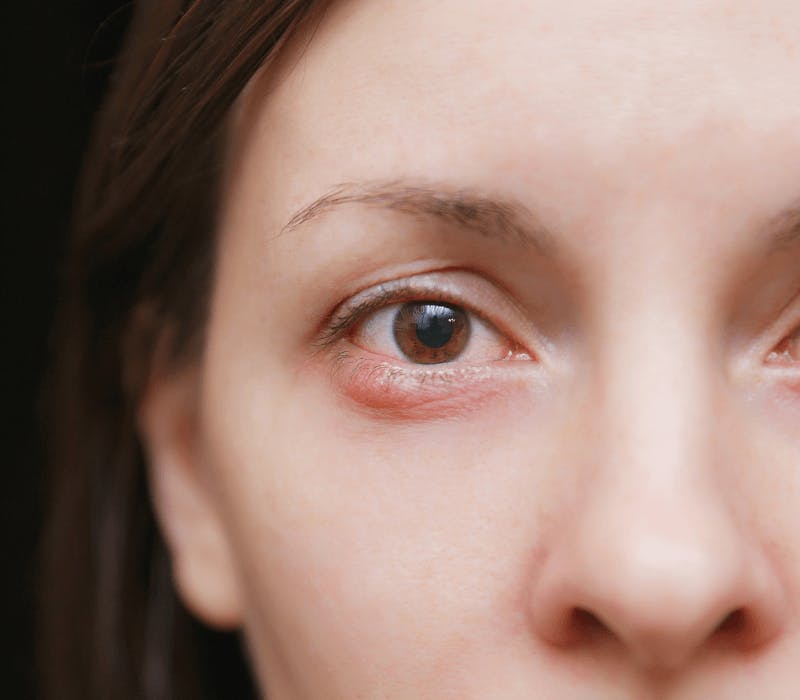
It might not affect your vision long-term and normally won’t last long, but it can definitely impact your ability to live a normal life while present.
So, What Is A Stye?
A stye, also referred to as a hordeolum, is an infection of the oil glands found on the edge of the eyelid. It’s caused by bacteria (generally the Staphylococcus species) that’s trapped inside the oil gland. It’s characterized by redness, inflammation, and a yellowish, pus-filled head that often resembles a pimple.
There are two major types of styes found near the eyelid -- an internal stye and an external stye. As you can likely imagine, internal styes are found on the inside of your eyelid and external styes are found on the outside of your eyelid. They’re easy to notice and normally easy to treat.
An external stye is normally an infection of the gland of zeis (which services the eyelash) or hair follicle. An internal stye is normally an infection of the meibomian gland (which is found on the inside of the eyelid). Either way, a stye can cause pain, irritation, and a displeasing appearance.
Will a Stye Naturally Heal?
Since a stye can be painful and irritating, many people are quick to ask how long they’ll need to live with it -- especially with an external eye that’s displeasing to look at. The good news is a stye generally heals naturally on its own. The normal healing process usually takes 7-10 days.
With that said, not everyone will see a stye disappear on its own within that 7-10 day period and other people might feel that 7-10 day period is far too long to wait. There are also a wide range of complications that can occur, further delaying the disappearance of a stye in the affected eye.
How to Get Rid Of a Stye Faster
If you’re experiencing a stye inside or outside of the eyelid or eyelids, it’s important to note that there are a variety of home remedies that can help you get rid of a stye more quickly. These are things everyone and anyone can safely accomplish, though the result is never guaranteed.
Let’s take a look at some of the best home remedies and other treatments for getting rid of a stye quicker:
Antibiotic Medication
If you visit your ophthalmologist, they might recommend an oral antibiotic or stye ointment to apply to the affected eye. Eye drops might also help ease the pain, though they won’t heal the stye.
Applying Warm Compresses
This is a very simple home treatment when dealing with a stye. All you need is a clean washcloth and warm water. Apply the warm washcloth to the affected eye several times per day until the stye goes away.
Tea Bag Compresses
This is similar to a warm compress, but instead of a washcloth you use a tea bag (preferably green tea). Soak the teabag in warm water and compress it to the affected eye.
Keep in mind that a home treatment isn’t designed to make the stye disappear right away and they aren’t 100% guaranteed to work for everyone. If you’re concerned about your stye worsening or not going away, you should contact Dr. Omar Shakir immediately for an eye exam.
How to Prevent a Stye From Worsening
While there are several home treatments that may help remove a stye quicker, it’s also important to note that there are things you can do to make the stye worse. If not handled properly, you can cause the bacterial infection to spread and further worsen the stye.
Contact Lenses
Make sure you wash your hands before putting in or taking out your contact lenses. You should also avoid reusing disposable contact lenses and ensure regular contact lenses are cleaned properly.
Popping the Stye
While your stye might look like a pimple, it’s far from it. You should never pop a stye because it might cause the pus to retract further into the infected area, promoting the spread of bacteria.
Applying Eye Makeup
Although you might want to apply eye makeup to the affected area, makeup will only slow the healing process and increase the chances of it overstaying its welcome.
Anytime you’re dealing with bacteria, it’s important you wash your hands regularly to avoid the spread of infection. This is especially important when touching your eyes, face, or eyelids -- such as in the case of a stye. You should also listen to the advice from a trusted eye doctor.
When Should You Visit Your Ophthalmologist?
A stye isn’t the worst thing that can happen to your eye health, but it most definitely can impede your ability to live a normal life. While they normally heal on their own, there are some instances when an appointment with your trusted and licensed ophthalmologist is necessary.
For example, you should schedule an appointment with Dr. Omar Shakir if a stye doesn’t go away within a week of it forming. You should also seek medical attention if the stye starts to affect your vision, starts bleeding, gets worse very quickly, starts to spread, or is recurring.
Dr. Omar Shakir will be able to find a safe and effective stye treatment for your eye. He takes every eye condition seriously and takes great pride in his ability to find the source of the problem, relieve the worry surrounding the patient, and initiate a proven solution to treat it.
Whether you’re concerned about a stye that just formed, worried about a stye that won’t go away, or simply want a comprehensive eye exam to prevent any further eye complications, contact Dr. Omar Shakir at Coastal Eye Surgeons immediately. We can’t wait to serve you!
Check out our article on What Is a Comprehensive Eye Exam & How Can It Help You?


